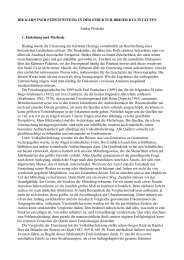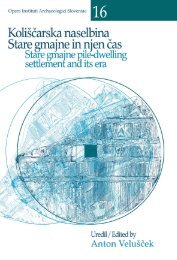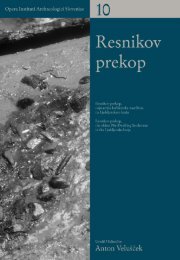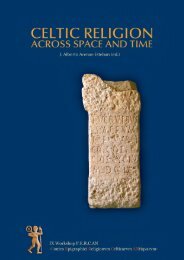The dedication to Antinous from Socanica In the course of ...
The dedication to Antinous from Socanica In the course of ...
The dedication to Antinous from Socanica In the course of ...
Create successful ePaper yourself
Turn your PDF publications into a flip-book with our unique Google optimized e-Paper software.
180 MARJETA ŠAŠEL KOS<br />
<strong>the</strong> Empire a sanctuary <strong>of</strong> <strong>Antinous</strong> has <strong>to</strong> date been unquestionably<br />
attested only in Lanuvium (7). Statues and sanctuaries were<br />
erected <strong>to</strong> <strong>Antinous</strong> after his death in AD 130, when he was<br />
immediately deified (8). <strong>In</strong>stead <strong>of</strong> iussu in <strong>the</strong> missing part <strong>of</strong> <strong>the</strong><br />
first line, Cerškov proposed et pro salute, which is not plausible in<br />
<strong>the</strong> context <strong>of</strong> this inscription.<br />
Sanctuaries dedicated <strong>to</strong> <strong>Antinous</strong> outside Egypt are very<br />
rare; in addition <strong>to</strong> <strong>the</strong> sanctuary in Lanuvium in Latium, a s<strong>to</strong>a<br />
with exedrae is mentioned in an inscription <strong>from</strong> Mantinea (9),<br />
and a sanctuary by Pausanias. This becomes understandable since<br />
Pausanias tells us that <strong>Antinous</strong> was worshipped in Mantinea<br />
because he was by birth <strong>from</strong> Bithynion, and <strong>the</strong> Bithynians would<br />
have allegedly originated <strong>from</strong> <strong>the</strong> Arcadians <strong>from</strong> Mantinea.<br />
Pausanias added that honours were decreed <strong>to</strong> <strong>Antinous</strong> on Hadrian’s<br />
instigation (8. 9. 7). A sanctuary is mentioned in Lanuvium in<br />
an inscription erected in AD 136 by <strong>the</strong> college <strong>of</strong> <strong>the</strong> elsewhere<br />
unattested worshippers <strong>of</strong> Diana and <strong>Antinous</strong> ([Lanuvii in] templo<br />
Antinoi...), who, among o<strong>the</strong>r activities, also provided burial<br />
for <strong>the</strong>ir deceased members (10). A college magistrate with priestly<br />
functions, a quinquennalis, <strong>of</strong>fered <strong>to</strong> <strong>the</strong> divinities frankincense<br />
and wine; Diana’s birthday on August 13 and <strong>Antinous</strong>’ birthday<br />
on November 27 were major holidays <strong>of</strong> <strong>the</strong> college, one <strong>of</strong> which<br />
was also <strong>the</strong> birthday <strong>of</strong> <strong>the</strong> patron <strong>of</strong> <strong>the</strong> city. No doubt <strong>the</strong>se<br />
holidays were celebrated publicly and <strong>the</strong> cult <strong>of</strong> <strong>Antinous</strong>, favoured<br />
by <strong>the</strong> imperial house, must have been popular among <strong>the</strong><br />
inhabitants <strong>of</strong> Lanuvium, and must have also represented a means<br />
<strong>of</strong> winning prestige in <strong>the</strong>ir city for <strong>the</strong> college (11). However, it<br />
has generally been considered that <strong>the</strong> cult <strong>of</strong> <strong>Antinous</strong> had not<br />
been popular in <strong>the</strong> western part <strong>of</strong> <strong>the</strong> Empire (12).<br />
(7) CIL XIV 2112; H. MEYER, Antinoos. Die archäologischen Denkmäler unter Einbeziehung<br />
des numismatischen und epigraphischen Materials sowie der literarischen Nachrichten. Ein Beitrag<br />
zur Kunst- und Kulturgeschichte der hadrianisch-frühan<strong>to</strong>ninischen Zeit, München 1991, pp. 207-<br />
208; M. BEARD, J. NORTH, S. PRICE, Religions <strong>of</strong> Rome, I-II, Cambridge, New York, Melbourne<br />
1998: vol. 1, pp. 272-273; vol. 2, pp. 292-294.<br />
(8) CH. W. CLAIRMONT, Die Bildnisse des <strong>Antinous</strong>. Ein Beitrag zur Portraetplastik unter<br />
Kaiser Hadrian (Bibl. Helvetica Romana VI), Rom 1966, p. 15 ff.; STEIN, PIR 2 A 737.<br />
(9) IG V, 2. 281 = SIG 3 841 = E. M. SMALLWOOD, Documents illustrating <strong>the</strong> principates <strong>of</strong><br />
Nerva, Trajan, and Hadrian, Cambridge 1966, no. 164.<br />
(10) ILS 7212 = FIRA 3. 35 = SMALLWOOD 1966 (cit.), no. 165.<br />
(11) F. M. AUSBÜTTEL, Untersuchungen zu den Vereinen im Westen des römischen<br />
Reiches (Frankfurter Althist. Stud. 11), Kallmünz 1982, pp. 22 ff.; 53; MEYER 1991 (cit. in n. 7),<br />
pp. 207-208.<br />
(12) E.g. J. BEAUJEU, La religion romaine à l’apogée de l’empire, I: La politique religieuse des<br />
An<strong>to</strong>nins, Paris 1955, p. 253 ff.










